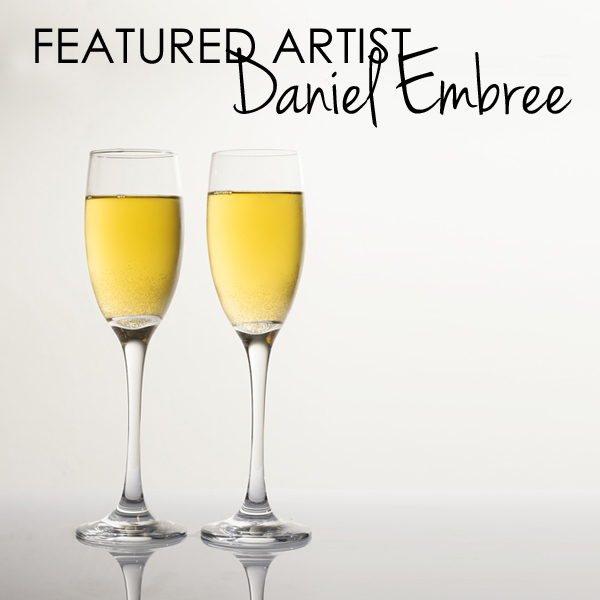I propose a TOAST!
Many of the artists that submit their work to be featured have deeply personal connections to their work. In a perfect world, all artists would have that same connection; however, the world isn’t perfect. Giving a voice to artists who have something to say has become one of the many great joys of this experience blogging experience.
As I often have to remind myself, choosing a Featured Artist is not about separating the good artwork from the bad. It has become about the challenge of picking from amongst ALL of the good work. Picking the right work at the right moment. Thanks, again, for that. Like many of you, my life is full of chances to walk the walk, not just talk the talk.
This month’s artist
walks and talks with an aesthetic of hope and celebration.
T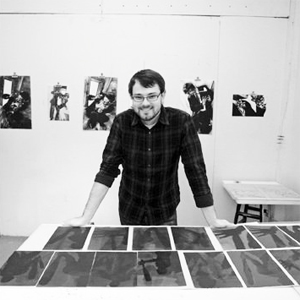 he Featured Artist chosen from February’s entries is artist Daniel Embree (pictured right in photo by Howard Romero). Embree’s work is a celebration of acceptance and the happiness that results. The work of Daniel Embree is like a black tie party of self-discovery and getting exactly what you deserve–at least eventually.
he Featured Artist chosen from February’s entries is artist Daniel Embree (pictured right in photo by Howard Romero). Embree’s work is a celebration of acceptance and the happiness that results. The work of Daniel Embree is like a black tie party of self-discovery and getting exactly what you deserve–at least eventually.
FEATURED ARTIST:
Daniel Embree
Though he is an emerging artist in New England, Embree’s pursuits have taken him from his home in Chicago to Utah and Los Angeles before bringing him to Boston, Massachusetts. Embree was raised in a conservative Mormon home in Chicago’s northern suburbs. His parents have always encouraged his love of art.
“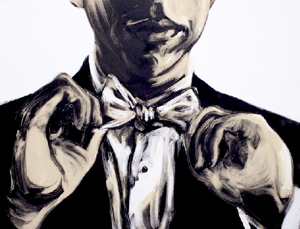 My mom taught me to be creative. I didn’t play with ninja turtle action figures as a kid. I made my own action figures out of clay—lizards, dragons, animals, mermaids, and giant insects. And my parents always praised my art. No matter what I was working on, it was always met with encouragement.” By the time he was eight he was taking classes at the Art Institute of Chicago with students 3x his age. Exposure to great art and information about artists at the Art Institute fueled his own aspirations.
My mom taught me to be creative. I didn’t play with ninja turtle action figures as a kid. I made my own action figures out of clay—lizards, dragons, animals, mermaids, and giant insects. And my parents always praised my art. No matter what I was working on, it was always met with encouragement.” By the time he was eight he was taking classes at the Art Institute of Chicago with students 3x his age. Exposure to great art and information about artists at the Art Institute fueled his own aspirations.
In the northern suburbs, Embree was also fortunate to have access to one of the best art programs in the region; his high school had eight art teachers. Upon graduating, he had a portfolio that showed breadth, depth, and consistency. Art schools across the country were competing for his attention.
“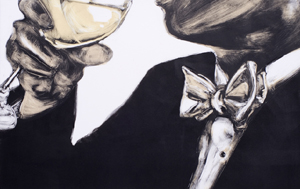 I had decided I was going to an art school in Boston,” Embree recalls, “My dad took me to Boston and there was a school there that really wanted me. I fell in love with the city instantly. That was where I wanted to live.”
I had decided I was going to an art school in Boston,” Embree recalls, “My dad took me to Boston and there was a school there that really wanted me. I fell in love with the city instantly. That was where I wanted to live.”
But that year, the Massachusetts Supreme Court legalized gay marriage.
“It scared me,” said Daniel, “At that time I was desperately trying to hide the fact that I was gay myself.” Embree was dedicated to the Mormon Church. “I didn’t just want to be an artist, I wanted to be a Mormon artist. I had grown up with lots of exposure to Mormon art, and my mom was always telling me that I could create better Mormon art—I had every intent to do just that.”
“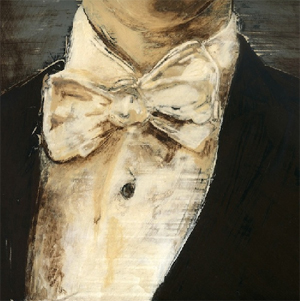 The fact that I grew up in a Church that did not tolerate homosexuality, went to a school that institutionalized discrimination, underwent reparative “ex-gay” therapy that didn’t work and ended up being very harmful, and was a missionary, makes my turnaround to acceptance and eventually marrying a man all the more powerful.” In 2009, Embree sought to broaden his scope and address the bigger issues inherent in his work. “I realized that really I was interested in how people treat each other,” he wrote in an artist statement, “I wanted to call attention to both our everyday interactions and how we address difficult situations.”
The fact that I grew up in a Church that did not tolerate homosexuality, went to a school that institutionalized discrimination, underwent reparative “ex-gay” therapy that didn’t work and ended up being very harmful, and was a missionary, makes my turnaround to acceptance and eventually marrying a man all the more powerful.” In 2009, Embree sought to broaden his scope and address the bigger issues inherent in his work. “I realized that really I was interested in how people treat each other,” he wrote in an artist statement, “I wanted to call attention to both our everyday interactions and how we address difficult situations.”
10 years from now I don’t want to be known as a gay artist, or as an artist who questions religion. It is true that I am a gay artist and that I do question religion, but I feel like the issues I bring into my art are bigger than both of those things, and in the future I would like to pursue them in broader ways to connect to a larger audience. Identity, authority, communication, relationships, personal struggle and acceptance are universal tropes that transcend my unique experiences.
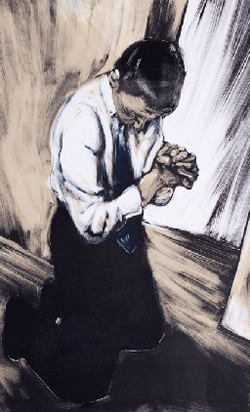 Embree’s most recent work has such a painterly effect, I had to ask, are you a print maker or a painter? “My work lately is definitely printmaking, but I don’t consider myself a printmaker. I am an artist, and I love to draw and paint too. I may be working on a body of paintings in the future, or I may be developing other printmaking techniques. I will work in whatever media inspires and motivates me, and fits the message I’m trying to convey.”
Embree’s most recent work has such a painterly effect, I had to ask, are you a print maker or a painter? “My work lately is definitely printmaking, but I don’t consider myself a printmaker. I am an artist, and I love to draw and paint too. I may be working on a body of paintings in the future, or I may be developing other printmaking techniques. I will work in whatever media inspires and motivates me, and fits the message I’m trying to convey.”
I am always fascinated by the motivation of printmakers to tackle a media, that by its very nature, expects perfection. But, of course, Embree revels in the lack of perfection–strives for it even. “The process entails rolling ink onto plexi-glass and then manipulating it before printing the remaining image onto paper. He rolls each color of ink individually and repeats the subtractive process with each color. The layers of ink stack on top of each other to create the final image.
Because the layers don’t always line up perfectly, the figures seem to quiver, as if they are moving.
The subtractive process of wiping the ink is also very gestural, and contributes to a sense of movement in the art. Embree’s most recent work really reinforces the image of the tuxedo. After such a struggle for acceptance, why use a shining symbol of celebration? Initially it was inspired by the tuxedos of my wedding, but 1920’s illustrations of men in tuxedos made him connect the image to something broader.
“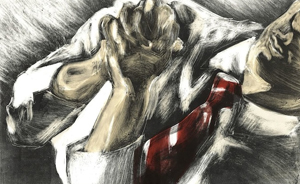 The twenties were a time when society was grappling with a lot of the same issues I grappled with. Americans were dealing with the restrictions of prohibition. They were also coming out of the stuffy Victorian era with a lot of social rules and pressures. Despite all of this, they were discovering new cultural freedoms—questioning gender inequities and roles, social boundaries & authority. They celebrated the end of struggle after World War I, and the rise of new technologies and prosperity. In a similar way, I am at a time in my life where things are working out and just starting to take off. By bringing all of that into my work, I think I can share what I feel in a way that can be read by a larger audience.
The twenties were a time when society was grappling with a lot of the same issues I grappled with. Americans were dealing with the restrictions of prohibition. They were also coming out of the stuffy Victorian era with a lot of social rules and pressures. Despite all of this, they were discovering new cultural freedoms—questioning gender inequities and roles, social boundaries & authority. They celebrated the end of struggle after World War I, and the rise of new technologies and prosperity. In a similar way, I am at a time in my life where things are working out and just starting to take off. By bringing all of that into my work, I think I can share what I feel in a way that can be read by a larger audience.
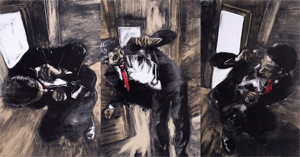 But what about the food? This IS, afterall, a food-themed art blog. I don’t know if I just attract foodie-artists or artistic foodies. Or, maybe artists just think that food is the way to my heart because most of the artists I interview have phenomenal culinary tastes. When Embree way asked? Diplomacy.
But what about the food? This IS, afterall, a food-themed art blog. I don’t know if I just attract foodie-artists or artistic foodies. Or, maybe artists just think that food is the way to my heart because most of the artists I interview have phenomenal culinary tastes. When Embree way asked? Diplomacy.
“I love too many foods to have a favorite, but I will pick out some flavors that I like. I especially love dishes that combine unlikely or contrasting flavors together. I love the mix of bitter-sweet lingonberries with savory meatballs or sweet mango with salty coconut sticky rice. I’m a sucker for everything bitter or tart—like dark chocolate, cranberry, or grapefruit.” And he doesn’t snack. I am suspicious of non-snacker. *snicker*

